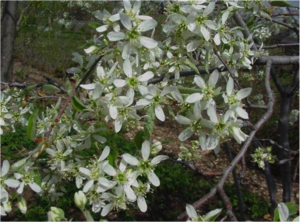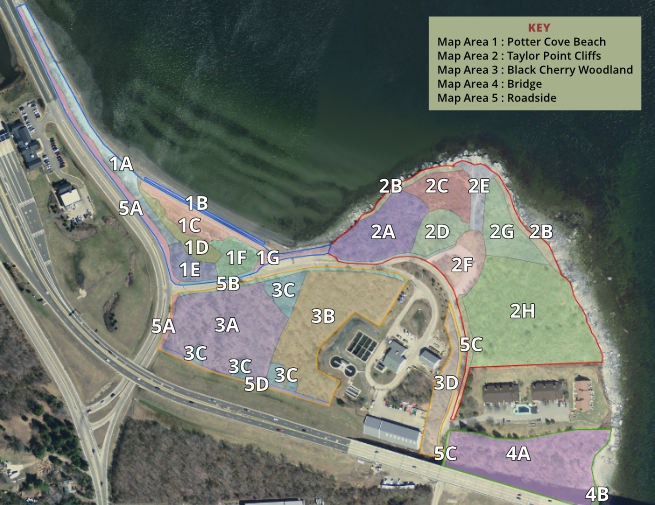Common Name: Shadbush, Eastern Shadbush, Canadian Serviceberry
Specific Name: Amelanchier canadensis
Known Occurrence at Taylor Point:
Map areas: Woodlands 3A, Woodland 3B, Woodlands 3C
Category: Native, Shrub

Ecological Considerations:
Amelanchier canadensis, commonly called shadbush or serviceberry, is a deciduous, early-flowering, large shrub or small tree which typically grows 15-30′ tall. Features showy, 5-petaled, slightly fragrant, white flowers in drooping clusters which appear before the leaves emerge in early spring. Finely toothed, elliptic, medium to dark green leaves (1-3″ long) change to orange-red in autumn. Flowers give way to small, round, green berries which turn red and finally mature to a dark purplish-black in early summer. Edible berries resemble blueberries in size and color and are used in jams, jellies and pies.
Invasive plants at Taylor Point that may possibly be replaced successfully by this plant:
Lonicera morrowii (Morrow’s honeysuckle)
Propagation Mechanisms/Strategies for Encouraging its Establishment:
Shadbush is easily grown in average, medium, well-drained soil in full sun to part shade and is tolerant of a somewhat wide range of soils.
Best Planting Practices/Options and Pros and Cons of Options:
Shadbush is best in woodland, naturalized or native plant gardens, especially with dark or shaded backdrops which tend to highlight the form, flowers and fall color of the plant. It is also effective along stream banks and ponds.
In the Northeast, it may be found growing in association with tupelo, speckled alder, poplar, hazel shrubs, white oak, red cedar, choke cherry, and bayberry.
Key Issues Regarding its Ecology ( e.g. Which Invasives Threaten it, What Conditions Favor it):
No serious insect or disease problems. Rust, leaf spot, blight and powdery mildew are sometime disease problems, and sawfly, leaf miner, borers and scale are sometime insect pests.
Associated Ecological Benefits:
Because shadbush is an early blooming plant, it plays an important role as a food source for pollinators like bees and butterflies. Birds and wildlife are very attracted to the plant’s fruit.
Availability of Locally Sourced Seeds and Plants:
Rhody Native
Evergreen Tree & Landscape
The Farmer’s Daughter
Wildwood Nurseriesi
Case Studies of Native Plant Establishment Efforts/Lessons Learned:
Additional photos:

Sources cited:
Missouri Botanical Garden
USDA Plant Guide
Search Rhode Island Native Plant Guide
Wildflower.org
Missouri Botanical Garden
Key Words:
Native
Shrub
Serviceberry
Shadbush
Amelanchier canadensis
